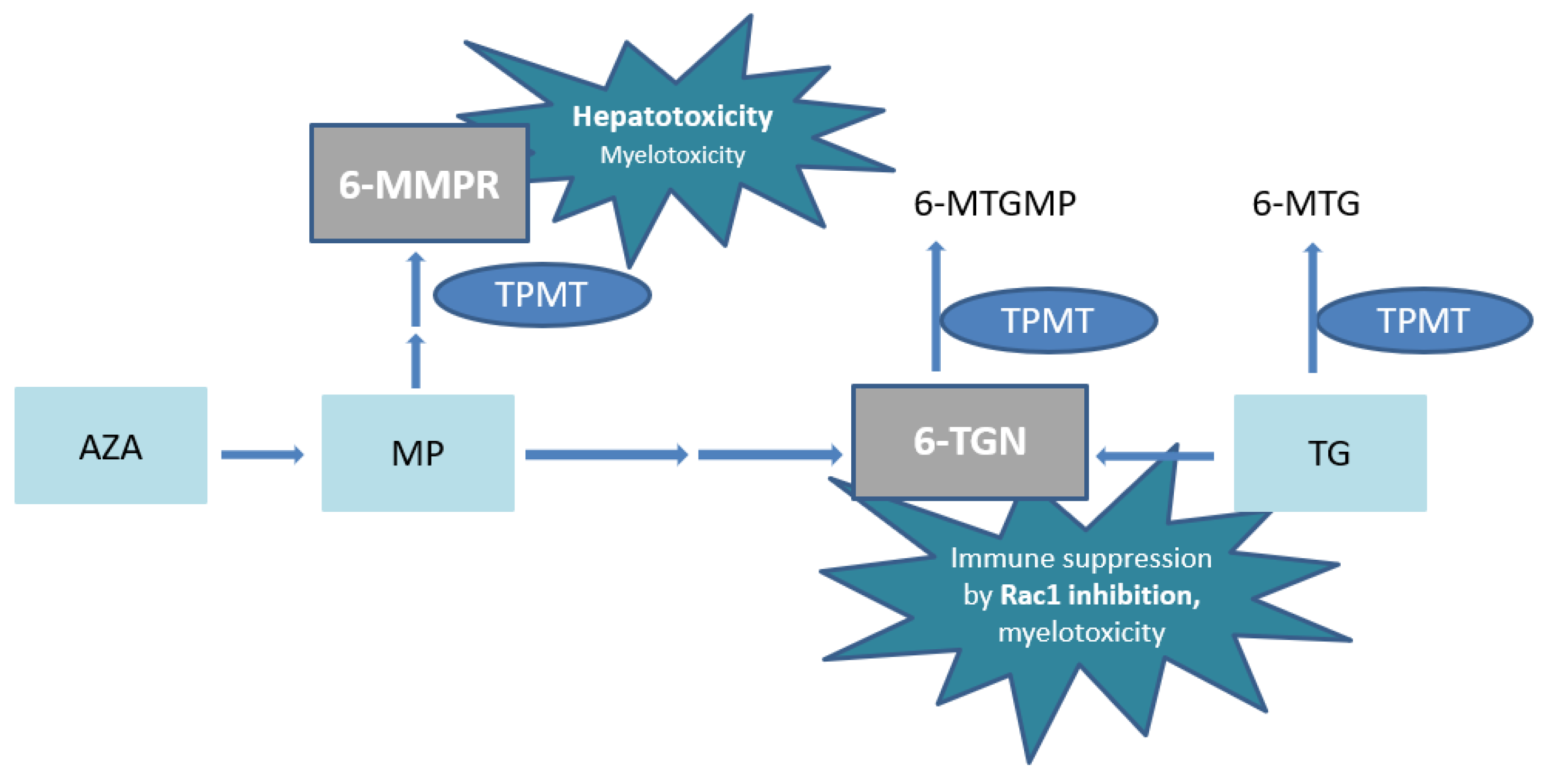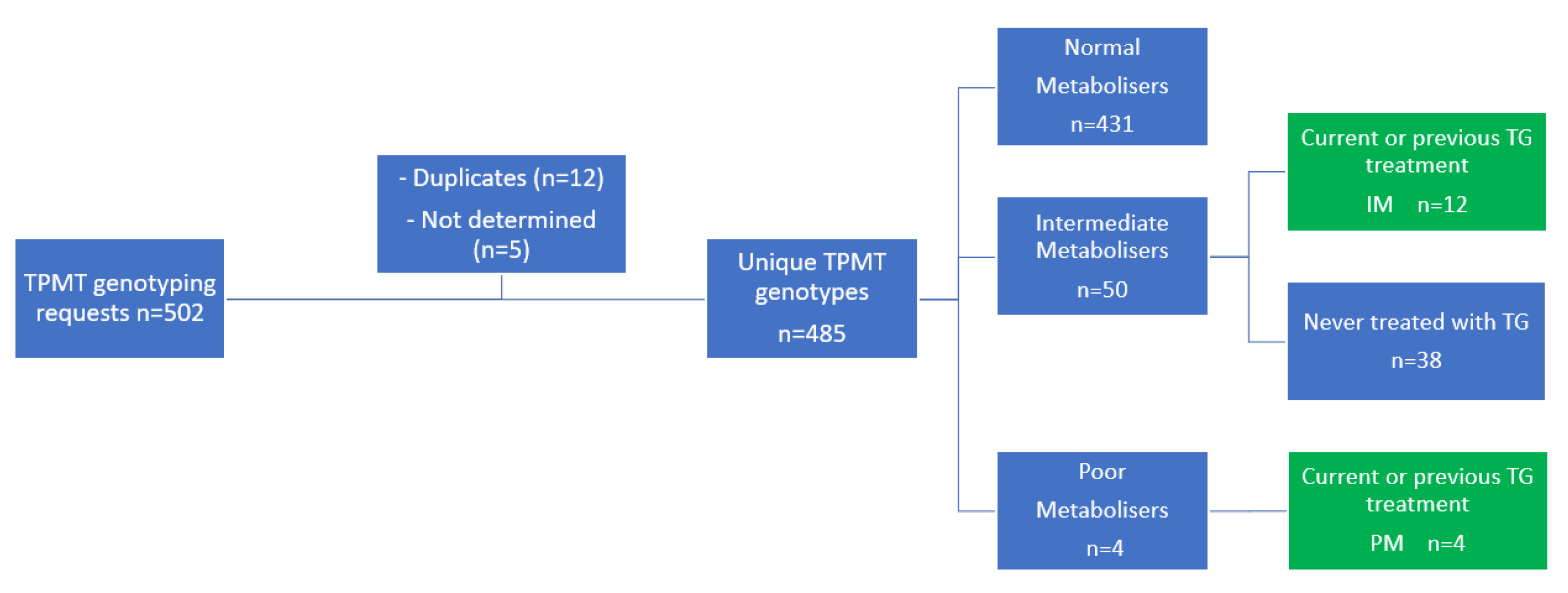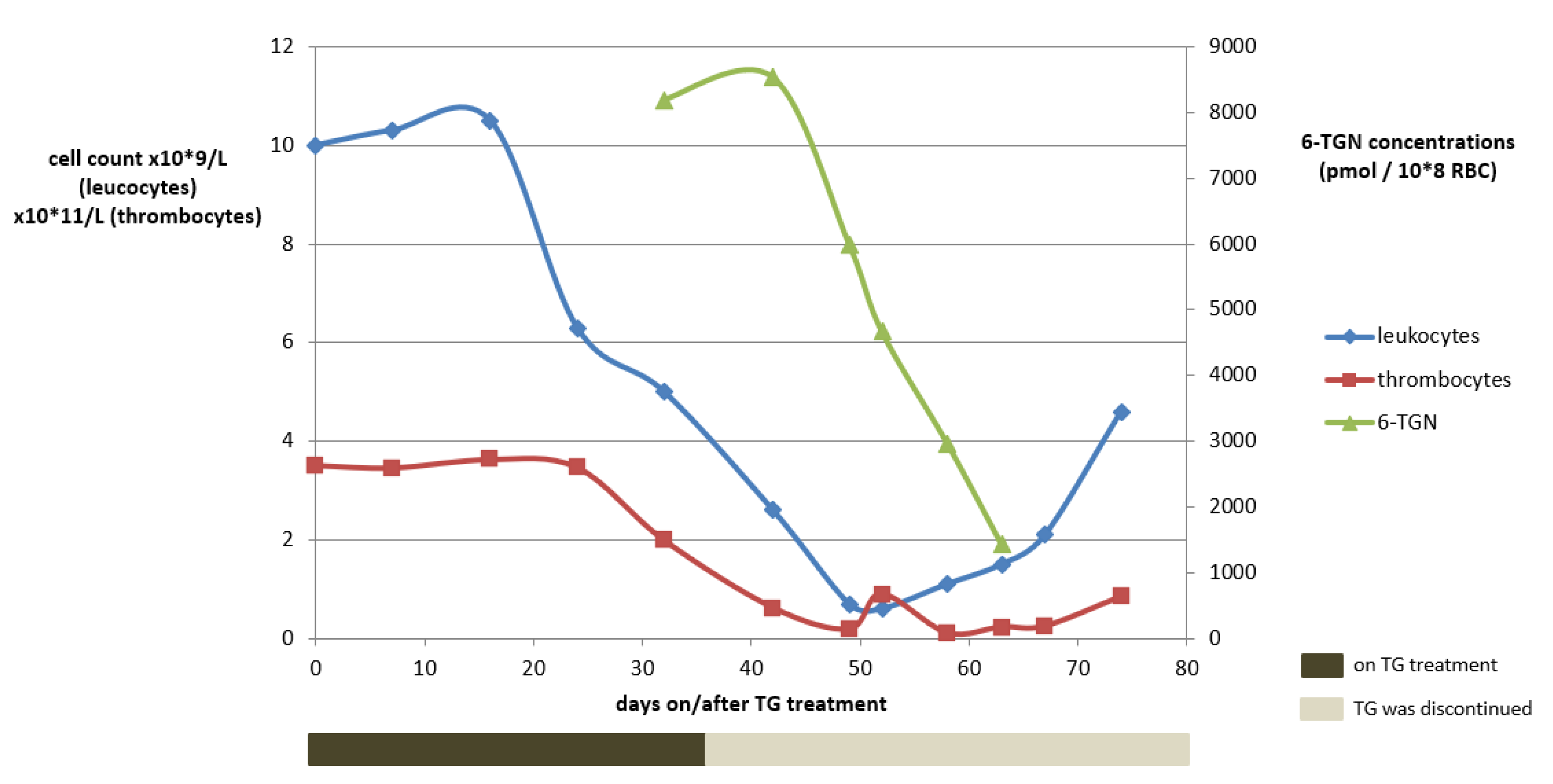Implications of Tioguanine Dosing in IBD Patients with a TPMT Deficiency
Abstract
:1. Introduction
2. Materials and Methods
2.1. Study Design and Patient Population
2.2. Data Collection
2.3. Thiopurine Metabolite Measurements
2.4. TPMT Genotype Measurements
2.5. Statistics
2.6. Ethical Considerations
3. Results
3.1. Patient Characteristics
3.2. Poor Metabolisers—Clinical Observations
3.2.1. Case 1
3.2.2. Case 2
3.2.3. Case 3
3.2.4. Case 4
3.3. Intermediate Metabolisers—Clinical Observations
4. Discussion
5. Conclusions
Author Contributions
Funding
Institutional Review Board Statement
Informed Consent Statement
Data Availability Statement
Conflicts of Interest
References
- Kaplan, G.G.; Windsor, J.W. The four epidemiological stages in the global evolution of inflammatory bowel disease. Nat. Rev. Gastroenterol. Hepatol. 2021, 18, 56–66. [Google Scholar] [CrossRef] [PubMed]
- Kotze, P.G.; Underwood, F.E.; Damião, A.O.M.C.; Ferraz, J.G.P.; Saad-Hossne, R.; Toro, M.; Iade, B.; Bosques-Padilla, F.; Teixeira, F.V.; Juliao-Banos, F.; et al. Progression of Inflammatory Bowel Diseases Throughout Latin America and the Caribbean: A Systematic Review. Clin. Gastroenterol. Hepatol. 2020, 18, 304–312. [Google Scholar] [CrossRef] [PubMed]
- Ng, S.C.; Shi, H.Y.; Hamidi, N.; Underwood, F.E.; Tang, W.; Benchimol, E.I.; Panaccione, R.; Ghosh, S.; Wu, J.C.Y.; Chan, F.K.L.; et al. Worldwide incidence and prevalence of inflammatory bowel disease in the 21st century: A systematic review of population-based studies. Lancet 2017, 390, 2769–2778. [Google Scholar] [CrossRef] [PubMed]
- Schwab, M.; Schäffeler, E.; Marx, C.; Fischer, C.; Lang, T.; Behrens, C.; Gregor, M.; Eichelbaum, M.; Zanger, U.M.; Kaskas, B.A. Azathioprine therapy and adverse drug reactions in patients with inflammatory bowel disease: Impact of thiopurine S-methyltransferase polymorphism. Pharmacogenetics 2002, 12, 429–436. [Google Scholar] [CrossRef] [PubMed]
- Jharap, B.; Seinen, M.L.; de Boer, N.K.; van Ginkel, J.R.; Linskens, R.K.; Kneppelhout, J.C.; Mulder, C.J.; van Bodegraven, A.A. Thiopurine therapy in inflammatory bowel disease patients: Analyses of two 8-year intercept cohorts. Inflamm. Bowel Dis. 2010, 16, 1541–1549. [Google Scholar] [CrossRef] [PubMed]
- Timmer, A.; Patton, P.H.; Chande, N.; McDonald, J.W.; MacDonald, J.K. Azathioprine and 6-mercaptopurine for maintenance of remission in ulcerative colitis. Cochrane Database Syst. Rev. 2016, 2016, CD000478. [Google Scholar] [CrossRef] [PubMed]
- De Boer, N.K.H.; Group, T.W. Thiopurine Therapy in Inflammatory Bowel Diseases: Making New Friends Should not Mean Losing Old Ones. Gastroenterology 2019, 156, 11–14. [Google Scholar] [CrossRef] [PubMed]
- Eriksson, C.; Rundquist, S.; Cao, Y.; Montgomery, S.; Halfvarson, J. Impact of thiopurines on the natural history and surgical outcome of ulcerative colitis: A cohort study. Gut 2019, 68, 623–632. [Google Scholar] [CrossRef]
- Dubinsky, M.C.; Yang, H.; Hassard, P.V.; Seidman, E.G.; Kam, L.Y.; Abreu, M.T.; Targan, S.R.; Vasiliauskas, E.A. 6-MP metabolite profiles provide a biochemical explanation for 6-MP resistance in patients with inflammatory bowel disease. Gastroenterology 2002, 122, 904–915. [Google Scholar] [CrossRef]
- Osterman, M.T.; Kundu, R.; Lichtenstein, G.R.; Lewis, J.D. Association of 6-thioguanine nucleotide levels and inflammatory bowel disease activity: A meta-analysis. Gastroenterology 2006, 130, 1047–1053. [Google Scholar] [CrossRef]
- Derijks, L.J.J.; Gilissen, L.P.L.; Engels, L.G.J.B.; Bos, L.P.; Bus, P.J.; Lohman, J.J.H.M.; Curvers, W.L.; Van Deventer, S.J.H.; Hommes, D.W.; Hooymans, P.M. Pharmacokinetics of 6-mercaptopurine in patients with inflammatory bowel disease: Implications for therapy. Ther. Drug Monit. 2004, 26, 311–318. [Google Scholar] [CrossRef] [PubMed]
- Dubinsky, M.C.; Lamothe, S.; Yang, H.Y.; Targan, S.R.; Sinnett, D.; Théorêt, Y.; Seidman, E.G. Pharmacogenomics and metabolite measurement for 6-mercaptopurine therapy in inflammatory bowel disease. Gastroenterology 2000, 118, 705–713. [Google Scholar] [CrossRef] [PubMed]
- Gilissen, L.; Derijks, L.; Verhoeven, H.; Bierau, J.; Hooymans, P.; Hommes, D.; Engels, L. Pancytopenia due to high 6-methylmercaptopurine levels in a 6-mercaptopurine treated patient with Crohn’s disease. Dig. Liver Dis. 2007, 39, 182–186. [Google Scholar] [CrossRef] [PubMed]
- Kreijne, J.E.; Seinen, M.L.; Wilhelm, A.J.; Bouma, G.; Mulder, C.J.; van Bodegraven, A.A.; de Boer, N.K.H. Routinely Established Skewed Thiopurine Metabolism Leads to a Strikingly High Rate of Early Therapeutic Failure in Patients with Inflammatory Bowel Disease. Ther. Drug Monit. 2015, 37, 797–804. [Google Scholar] [CrossRef]
- Turbayne, A.K.; Sparrow, M.P. Low-Dose Azathioprine in Combination with Allopurinol: The Past, Present and Future of This Useful Duo. Dig. Dis. Sci. 2022, 67, 5382–5391. [Google Scholar] [CrossRef] [PubMed]
- Seinen, M.L.; van Asseldonk, D.P.; Mulder, C.J.J.; de Boer, N.K.H. Dosing 6-thioguanine in inflammatory bowel disease: Expert-based guidelines for daily practice. J. Gastrointestin. Liver Dis. 2010, 19, 291–294. [Google Scholar]
- Eqbal, A.; Martin, A.; Doecke, J.D.; Patrick, D. Low-dose thioguanine guided by therapeutic drug monitoring is a safe and effective alternative in inflammatory bowel disease patients intolerant to conventional thiopurines. Intern. Med. J. 2023, 53, 559–567. [Google Scholar] [CrossRef]
- Simsek, M.; Meijer, B.; van Bodegraven, A.A.; de Boer, N.K.H.; Mulder, C.J.J. Finding hidden treasures in old drugs: The challenges and importance of licensing generics. Drug Discov. Today 2018, 23, 17–21. [Google Scholar] [CrossRef]
- Simsek, M.; Deben, D.S.; Horjus, C.S.; Bénard, M.V.; Lissenberg-Witte, B.I.; Buiter, H.J.C.; van Luin, M.; Seinen, M.L.; Mulder, C.J.J.; Wong, D.R.; et al. Sustained effectiveness, safety and therapeutic drug monitoring of tioguanine in a cohort of 274 IBD patients intolerant for conventional therapies. Aliment. Pharmacol. Ther. 2019, 50, 54–65. [Google Scholar] [CrossRef]
- Biemans, V.B.C.; Savelkoul, E.; Gabriëls, R.Y.; Simsek, M.; Dijkstra, G.; Pierik, M.J.; West, R.L.; de Boer, N.K.; Hoentjen, F. A comparative analysis of tioguanine versus low-dose thiopurines combined with allopurinol in inflammatory bowel disease patients. Aliment. Pharmacol. Ther. 2020, 51, 1076–1086. [Google Scholar] [CrossRef]
- Zorginstituut Nederland/GIP. Actueel Aantal Gebruikers Tioguanine (Thiosix). 2022. Available online: https://www.gipdatabank.nl/databank?infotype=g&label=00-totaal&tabel_g_00-totaal=B_01-basis&tabel_h_00-totaal=B_01-basis&geg=gebr&spec=&item=L01BB03 (accessed on 4 January 2022).
- Relling, M.V.; Schwab, M.; Whirl-Carrillo, M.; Suarez-Kurtz, G.; Pui, C.-H.; Stein, C.M.; Moyer, A.M.; Evans, W.E.; Klein, T.E.; Antillon-Klussmann, F.G.; et al. Clinical Pharmacogenetics Implementation Consortium Guideline for Thiopurine Dosing Based on TPMT and NUDT15 Genotypes: 2018 Update. Clin. Pharmacol. Ther. 2019, 105, 1095–1105. [Google Scholar] [CrossRef] [PubMed]
- Dubinsky, M.C.; Hassard, P.V.; Seidman, E.G.; Kam, L.Y.; Abreu, M.T.; Targan, S.R.; Vasiliauskas, E.A. An open-label pilot study using thioguanine as a therapeutic alternative in Crohn’s disease patients resistant to 6-mercaptopurine therapy. Inflamm. Bowel Dis. 2001, 7, 181–189. [Google Scholar] [CrossRef] [PubMed]
- Pavlidis, P.; Ansari, A.; Duley, J.; Oancea, I.; Florin, T. Splitting a therapeutic dose of thioguanine may avoid liver toxicity and be an efficacious treatment for severe inflammatory bowel disease: A 2-center observational cohort study. Inflamm. Bowel Dis. 2014, 20, 2239–2246. [Google Scholar] [CrossRef] [PubMed]
- Toksvang, L.N.; Schmidt, M.S.; Arup, S.; Larsen, R.H.; Frandsen, T.L.; Schmiegelow, K.; Rank, C.U. Hepatotoxicity during 6-thioguanine treatment in inflammatory bowel disease and childhood acute lymphoblastic leukaemia: A systematic review. PLoS ONE 2019, 14, e0212157. [Google Scholar] [CrossRef] [PubMed]
- Gilissen, L.P.L.; Tajzai, R.; Romberg, M.; Pierik, M.; Stronkhorst, A.; Steenhuisen, K.; Van Bodegraven, A.; Daniels, A.; Wong, D. The prevalence of nodular regenerative hyperplasia of the liver in long-term thiopurine-treated inflammatory bowel disease patients. Eur. J. Gastroenterol. Hepatol. 2020, 33, e102–e107. [Google Scholar] [CrossRef] [PubMed]
- Gilissen, L.P.; Derijks, L.J.; Driessen, A.; Bos, L.P.; Hooymans, P.M.; Stockbrügger, R.W.; Engels, L.G.J.B. Toxicity of 6-thioguanine: No hepatotoxicity in a series of IBD patients treated with long-term, low dose 6-thioguanine. Some evidence for dose or metabolite level dependent effects? Dig. Liver Dis. 2007, 39, 156–159. [Google Scholar] [CrossRef]
- Derijks, L.J.; Gilissen, L.P.; de Boer, N.K.; Mulder, C.J. 6-Thioguanine-related hepatotoxicity in patients with inflammatory bowel disease: Dose or level dependent? J. Hepatol. 2006, 44, 821–822. [Google Scholar] [CrossRef]
- Bayoumy, A.B.; Simsek, M.; Seinen, M.L.; Mulder, C.J.J.; Ansari, A.; Peters, G.J.; De Boer, N.K. The continuous rediscovery and the benefit-risk ratio of thioguanine, a comprehensive review. Expert Opin. Drug Metab. Toxicol. 2020, 16, 111–123. [Google Scholar] [CrossRef]
- Geneesmiddelen, C. College ter B van. SmPC Tioguanine (Thiosix). 2020. Available online: https://www.geneesmiddeleninformatiebank.nl/smpc/h114681_smpc.pdf (accessed on 22 June 2021).
- Dickson, A.L.; Daniel, L.L.; Zanussi, J.; Plummer, W.D.; Wei, W.Q.; Liu, G.; Reese, T.; Anandi, P.; Birdwell, K.A.; Kawai, V.; et al. TPMT and NUDT15 Variants Predict Discontinuation of Azathioprine for Myelotoxicity in Patients with Inflammatory Disease: Real-World Clinical Results. Clin. Pharmacol. Ther. 2021, 111, 263–271. [Google Scholar] [CrossRef]
- Dervieux, T.; Boulieu, R. Simultaneous determination of 6-thioguanine and methyl 6-mercaptopurine nucleotides of azathioprine in red blood cells by HPLC. Clin. Chem. 1998, 44, 551–555. [Google Scholar] [CrossRef]
- Derijks, L.J.; Gilissen, L.P.; Engels, L.G.; Bos, L.P.; Bus, P.J.; Lohman, J.J.; van Deventer, S.J.H.; Hommes, D.W.; Hooymans, P.M. Pharmacokinetics of 6-thioguanine in patients with inflammatory bowel disease. Ther. Drug Monit. 2006, 28, 45–50. [Google Scholar] [CrossRef] [PubMed]
- Crouwel, F.; Simsek, M.; Mulder, C.J.; Buiter, H.J.; De Boer, N.K. Thioguanine Therapy in Inflammatory Bowel Diseases. A Practical Guide. J. Gastrointest. Liver Dis. 2020, 29, 637–645. [Google Scholar] [CrossRef] [PubMed]
- Ward, M.G.; Patel, K.V.; Kariyawasam, V.C.; Goel, R.; Warner, B.; Elliott, T.R.; Blaker, P.; Irving, P.M.; Marinaki, A.M.; Sanderson, J.D. Thioguanine in inflammatory bowel disease: Long-term efficacy and safety. United Eur. Gastroenterol. J. 2017, 5, 563–570. [Google Scholar] [CrossRef] [PubMed]
- Van der Burg, M.; Gerding, M.N. Pancytopenie Bij Tioguaninegebruik. Ned. Tijdschr. Geneeskd. 2018, 162. Available online: https://www.ntvg.nl/artikelen/pancytopenie-bij-tioguaninegebruik/artikelinfo (accessed on 4 January 2022).
- De Hoogd, S.; Wong, D.R.; de Vries, D.R.; Harmsze, A.M. Severe pancytopenia and aspergillosis caused by thioguanine in a thiopurine S-methyltransferase deficient patient: A case report. Eur. J. Gastroenterol. Hepatol. 2019, 31, 1592–1596. [Google Scholar] [CrossRef] [PubMed]
- Bayoumy, A.B.; Mulder, C.J.J.; Loganayagam, A.; Sanderson, J.D.; Anderson, S.; Boekema, P.J.; Derijks, L.J.J.; Ansari, A.R. Relationship between Thiopurine S-Methyltransferase Genotype/Phenotype and 6-Thioguanine Nucleotide Levels in 316 Patients with Inflammatory Bowel Disease on 6-Thioguanine. Ther. Drug Monit. 2021, 43, 617–623. [Google Scholar] [CrossRef]
- Wong, D.R.; Coenen, M.J.; Vermeulen, S.H.; Derijks, L.J.; van Marrewijk, C.J.; Klungel, O.H.; Scheffer, H.; Franke, B.; Guchelaar, H.-J.; de Jong, D.J.; et al. Early Assessment of Thiopurine Metabolites Identifies Patients at Risk of Thiopurine-induced Leukopenia in Inflammatory Bowel Disease. J. Crohns Colitis 2017, 11, 175–184. [Google Scholar] [CrossRef] [PubMed]
- Mares, W.G.; Wong, D.R.; Gilissen, L.P.; Masclee, A.A.; Hooymans, P.M.; Engels, L.G. Safe 6-thioguanine therapy of a TPMT deficient Crohn’s disease patient by using therapeutic drug monitoring. J. Crohns Colitis 2009, 3, 128–130. [Google Scholar] [CrossRef]
- Lennard, L. Implementation of TPMT testing. Br. J. Clin. Pharmacol. 2014, 77, 704–714. [Google Scholar] [CrossRef]
- Krynetski, E.Y.; Evans, W.E. Genetic polymorphism of thiopurine S-methyltransferase: Molecular mechanisms and clinical importance. Pharmacology 2000, 61, 136–146. [Google Scholar] [CrossRef]



| TPMT Genotype | Sex | Age (Years) | Body-Weight (kg) | BMI (kg/m2) | IBD Disease Type | TG Daily Maintenance Dose (mg) | TG Daily Dose (mg/kg) | TG Dose Percentage of Registered Dose # | TG Treatment Duration (Months) | Reason for TG Discontinuation | 6-TGN Concentrations (pmol/8 × 108 RBC) | |
|---|---|---|---|---|---|---|---|---|---|---|---|---|
| Poor TPMT metabolisers | *3A/*3A | F | 48 | 73 | 23.0 | UC | 10 | 0.14 | 46.7% | 1 | Severe pancytopenia | Range 729–8536 |
| *3A/*3C | F | 25 | 66 | 24.2 | UC | 0.7 | 0.011 | 3.7% | 12 | Patient’s own request | Range 306–3872 | |
| *3A/c.702T > A | F | 19 | 63 | 21.0 | CD | 0.24 | 0.0038 | 1.3% | 9 | N.A. | Range 435–4051 | |
| *3A/*9 | F | 23 | 67 | 25.2 | CD | 1.4 | 0.021 | 7.0% | 5 | N.A. | Range 333–529 | |
| Intermediate TPMT metabolisers | *1/*3A | F | 23 | 76 | 23.5 | CD | 5 | 0.07 | 21.9% | 11 | Refractory disease | 323 |
| *1/*9 | F | 55 | 70 | 24.8 | CD | 5 | 0.07 | 23.8% | 2 | Joint pain | N.A. | |
| *1/*3A | F | 59 | 60 | 19.4 | UC | 5 | 0.08 | 27.8% | 31 | N.A. | 511 | |
| *1/*3A | F | 48 | 79 | 24.9 | CD | 10 | 0.13 | 42.2% | 30 | N.A. | 725 | |
| *1/*3A | F | 43 | 80 | 32.0 | CD | 3.33 | 0.04 | 13.9% | 37 | Clinical remission | 574 | |
| *1/*3C | F | 22 | 82 | 25.9 | CD | 5 | 0.06 | 20.3% | 23 | N.A. | 462 | |
| *1/*3A | F | 22 | 56 | 22.4 | UC | 20 | 0.36 | 119.0% | 48 | Toxic 6-TGN concentration | 4065 | |
| *1/*3A | F | 55 | 78 | 24.9 | UC | 5 | 0.06 | 21.4% | 4 | Refractory disease | 610 | |
| *1/*3A | F | 28 | 78 | 28.7 | CD | 10 | 0.13 | 42.7% | 5 | Joint pain and sun allergy | 850 | |
| *1/*2 | M | 66 | 79 | 28.3 | CD | 10 | 0.13 | 42.2% | 10 | N.A. | 421 | |
| *1/*3A | M | 71 | 90 | 28.4 | UC | 5 | 0.06 | 18.5% | 4 | Patient’s own request | 820 | |
| *1/*3A | M | 63 | 76 | 23.2 | UC | 5 | 0.07 | 21.9% | 36 | Patient’s own request | 431 |
Disclaimer/Publisher’s Note: The statements, opinions and data contained in all publications are solely those of the individual author(s) and contributor(s) and not of MDPI and/or the editor(s). MDPI and/or the editor(s) disclaim responsibility for any injury to people or property resulting from any ideas, methods, instructions or products referred to in the content. |
© 2023 by the authors. Licensee MDPI, Basel, Switzerland. This article is an open access article distributed under the terms and conditions of the Creative Commons Attribution (CC BY) license (https://creativecommons.org/licenses/by/4.0/).
Share and Cite
Deben, D.S.; Derijks, L.J.J.; van den Bosch, B.J.C.; Creemers, R.H.; van Nunen, A.; van Bodegraven, A.A.; Wong, D.R. Implications of Tioguanine Dosing in IBD Patients with a TPMT Deficiency. Metabolites 2023, 13, 1054. https://doi.org/10.3390/metabo13101054
Deben DS, Derijks LJJ, van den Bosch BJC, Creemers RH, van Nunen A, van Bodegraven AA, Wong DR. Implications of Tioguanine Dosing in IBD Patients with a TPMT Deficiency. Metabolites. 2023; 13(10):1054. https://doi.org/10.3390/metabo13101054
Chicago/Turabian StyleDeben, Debbie S., Luc J. J. Derijks, Bianca J. C. van den Bosch, Rob H. Creemers, Annick van Nunen, Adriaan A. van Bodegraven, and Dennis R. Wong. 2023. "Implications of Tioguanine Dosing in IBD Patients with a TPMT Deficiency" Metabolites 13, no. 10: 1054. https://doi.org/10.3390/metabo13101054
APA StyleDeben, D. S., Derijks, L. J. J., van den Bosch, B. J. C., Creemers, R. H., van Nunen, A., van Bodegraven, A. A., & Wong, D. R. (2023). Implications of Tioguanine Dosing in IBD Patients with a TPMT Deficiency. Metabolites, 13(10), 1054. https://doi.org/10.3390/metabo13101054





_Derijks.png)

